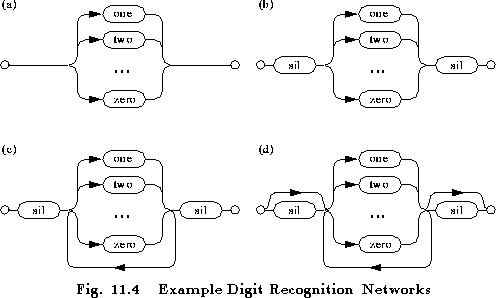
Whilst the construction of a word level SLF network file by hand is not difficult, it can be somewhat tedious. In earlier versions of HTK, a high level grammar notation based on extended Backus-Naur Form (EBNF ) was used to specify recognition grammars. This HParse format was read-in directly by the recogniser and compiled into a finite state recognition network at run-time.
In HTK V2.0 , HParse format is still supported but in the form of an off-line compilation into an SLF word network which can subsequently be used to drive a recogniser.
A HParse format grammar consists of an extended form of regular expression enclosed within parentheses. Expressions are constructed from sequences of words and the metacharacters
As a first example, suppose that a simple isolated word single digit recogniser was required. A suitable syntax would be
(
one | two | three | four | five |
six | seven | eight | nine | zero
)
This would translate into the network shown in part (a) of
Fig. 11.4.
If this HParse format syntax definition
was stored in a file called digitsyn,
the equivalent SLF word network would be generated in the
file digitnet by typing
HParse digitsyn digitnet
The above digit syntax assumes that each input digit is properly end-pointed. This requirement can be removed by adding a silence model before and after the digit
(
sil (one | two | three | four | five |
six | seven | eight | nine | zero) sil
)
As shown by graph (b) in Fig. 11.4, the allowable sequence of
models now consists of silence followed by a digit followed by silence.
If a sequence of digits needed to be recognised then angle brackets can
be used to indicate one or more repetitions, the HParse grammar
(
sil < one | two | three | four | five |
six | seven | eight | nine | zero > sil
)
would accomplish this.
Part (c) of Fig. 11.4
shows the network that would result in this case.
HParse grammars can define variables to represent sub-expressions. Variable names start with a dollar symbol and they are given values by definitions of the form
$var = expression ;For example, the above connected digit grammar could be rewritten as
$digit = one | two | three | four | five |
six | seven | eight | nine | zero;
(
sil < $digit > sil
)
Here $digit is a variable whose value is the expression appearing
on the right hand side of the assignment. Whenever the name of a variable
appears within an expression, the corresponding expression is substituted.
Note however that variables must be defined before use, hence, recursion
is prohibited.
As a final refinement of the digit grammar, the start and end silence can be made optional by enclosing them within square brackets thus
$digit = one | two | three | four | five |
six | seven | eight | nine | zero;
(
[sil] < $digit > [sil]
)
Part (d) of Fig. 11.4
shows the network that would result in this last case.
HParse format grammars are a convenient way of specifying task grammars for interactive voice interfaces. As a final example, the following defines a simple grammar for the control of a telephone by voice.
$digit = one | two | three | four | five |
six | seven | eight | nine | zero;
$number = $digit { [pause] $digit};
$scode = shortcode $digit $digit;
$telnum = $scode | $number;
$cmd = dial $telnum |
enter $scode for $number |
redial | cancel;
$noise = lipsmack | breath | background;
( < $cmd | $noise > )
The dictionary entries for pause, lipsmack,
breath and background would reference HMMs trained
to model these types of noise and the corresponding output symbols
in the dictionary would be null.
Finally, it should be noted that when the HParse format was used in earlier versions of HTK, word grammars contained word pronunciations embedded within them. This was done by using the reserved node names WD_BEGIN and WD_END to delimit word boundaries. To provide backwards compatiblity, HPARSE can process these old format networks but when doing so it outputs a dictionary as well as a word network. This compatibility mode is defined fully in the reference section, to use it the configuration variable V1COMPAT must be set true or the -c option set.
Finally on the topic of word networks , it is important to note that any network containing an unbroken loop of one or more tee-models will generate an error. For example, if sp is a single state tee-model used to represent short pauses, then the following network would generate an error
( sil < sp | $digit > sil )the intention here is to recognise a sequence of digits which may optionally be separated by short pauses. However, the syntax allows an endless sequence of sp models and hence, the recogniser could traverse this sequence without ever consuming any input. The solution to problems such as these is to rearrange the network. For example, the above could be written as
( sil < $digit sp > sil )